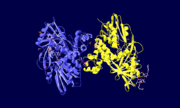Glycerol-3-Phosphate Dehydrogenase
From Proteopedia
| Line 42: | Line 42: | ||
==3D structures of glycerol-3-phosphate dehydrogenase== | ==3D structures of glycerol-3-phosphate dehydrogenase== | ||
| - | + | Updated on {{REVISIONDAY2}}-{{MONTHNAME|{{REVISIONMONTH}}}}-{{REVISIONYEAR}} | |
[[3da1]] – GPDH + FAD – ''Bacillus halodurans''<br /> | [[3da1]] – GPDH + FAD – ''Bacillus halodurans''<br /> | ||
Revision as of 08:44, 10 March 2013
Glycerol-3-phosphate dehydrogenase (GlpD) is a membrane bound enzyme in prokaryotes and in eukaryotes. Glycerol 3-Phosphate Dehydrogenase (GlpD) is an oxidoreductase enzyme which catalyzes the reduction in reaction of Dihydroxyacetone Phosphate to Glycerol 3-Phosphate, with NADH as the reductant. GlpD is involved in many cellular functions such as phospholipids biosynthesis, respiration and metabolism. [1]The GlpD is a dimer consisting of two subunits which contain the catabolite activator protein (CAP)-Domain,the flavin adenine dinucleotide(FAD)-Domain and a ubiquinone analogue, MD.
Contents |
Structure
GlpD is a dimer that consists of two subunits; α and β. The GlpD structure also contains seven ligands; 1,3-Dihydroxyacetonephosphate (13P), β-Octylglucoside (βOG), 1,2-Ethanediol (EDO), Flavin-Adenine Dinucleotide (FAD), Imidazole (IMD), PO4 (Phosphate Ion) and N-(Tris(Hydroxymethyl)methyl)-3-Aminopropanesulfonic Acid (T3A). The active sites on GlpD are the Cap-Domain, FAD- Domain and a ubiquinone substrate analogue, menadione (MD).
The C-terminal CAP-Domain consists of negatively charged residues that are opposite in orientation to the positively charged residues of the FAD-Domain in the phospholipid membrane. The CAP-domain is responsible in gene transcription and helical turns.
The N-terminal FAD-Domain exists in each monomer subunit of GlpD and is embedded into the phospholipid membrane bilayer.Substrate binding occurs at this domain which causes a conformational change to the structure of the GlpD enzyme. The FAD-domain plays a major role in metabolism and energy synthesis.
Function
GlpD functions in the intracellular membrane of E. coli and in the inner-mitochondrial membrane of eukaryotes. In E. Coli, GlpD catalyzes and reduces the reaction of dihydroxyacetone phosphate to glycerol 3-phosphate in the glycerol metabolism pathway. The binding of the substrate analogues (glyceraldehydes 3-phosphate, glyceric acid 2-phosphate and phosphoenolpyruvate, dihydroxyacetone phosphate)or UQ substrate analogues (2-n-heptyl-4-hydroxyquinoline N-oxide and menadione). The conformational change of the structure and resiudes of GlpD catalyzes many different metabolic reactions.
Metabolic Pathways
Phosphoplipid Biosynthesis
GlpD reduces dihydroxyacetone phosphate to glycerol 3-phosphate. Then the glycerol 3-phosphate is catalyzed by acyl transferase to 1-acylglyverol-3-phosphate, and then another acyl transferase catalyzes that to a phosphatidic acid. head groups are added to the phosphatidic acid to synthesize phospholipids.
Glyceroneogenesis
GlpD is also involved in the glyceroneogenesis pathway. By gluconeogenesis, phosphoenolpyruvate converts to dihydroxyacetone phosphate which is reduced by GlpD to glycerol 3-phosphate which then forms a backbone for the synthesis of triacylglycerol.
Respiration
The FAD-domain in GlpD plays a major role in the transport of electrons into the repiratory pathway. Glycerol 3-phosphate is oxidized to dihydroxyacetone phosphate with simultaneous reduction of of FAD to FADH2 occuring, and the electrons are transported to Ubiquinone, which are further transported to oxygen or nitrogen and into the respiratory pathway.
Diseases
GlpD is involved in diseases such as alzeheimer`s, muscle dystrophy, hyaline membrane diseases and many more.
3D structures of glycerol-3-phosphate dehydrogenase
Updated on 10-March-2013
3da1 – GPDH + FAD – Bacillus halodurans
2qcu - EcGPDH + FAD – Escherichia coli
2r4j, 2r4e - EcGPDH + FAD + DHAP
2r46 - EcGPDH + FAD + 2-phosphopyruvic acid
2r45 - EcGPDH + FAD + 2-phospho-glyceric acid
1yj8 – GPDH – Plasmodium falciparum
NADPH-dependent GPDH
3k96 – GPDH – Coxiella burnetii
2pla, 1x0x – hGPDH + NAD – human
1wpq - hGPDH + NAD + DHA
1x0v – hGPDH
4fgw – GPDH - yeast
1z82 – GPDH + NADP + G3P + glyceraldehydes-3-phosphate – Thermotoga maritima
1txg – GPDH + glycerol – Archaeoglobus fulgidus
1evy – GPDH – Leishmania mexicana
1n1g, 1m66, 1m67, 1jdj – LmGPDH + inhibitor
1evz - LmGPDH + NAD
1n1e – LmGPDH + NAD + DHAP
References
- ↑ Yeh JI, Chinte U, Du S. Structure of glycerol-3-phosphate dehydrogenase, an essential monotopic membrane enzyme involved in respiration and metabolism. Proc Natl Acad Sci U S A. 2008 Mar 4;105(9):3280-5. Epub 2008 Feb 22. PMID:18296637
Proteopedia Page Contributors and Editors (what is this?)
Indu Toora, Michal Harel, Alexander Berchansky, David Canner, Andrea Gorrell, Andrew Rebeyka, Jaime Prilusky

